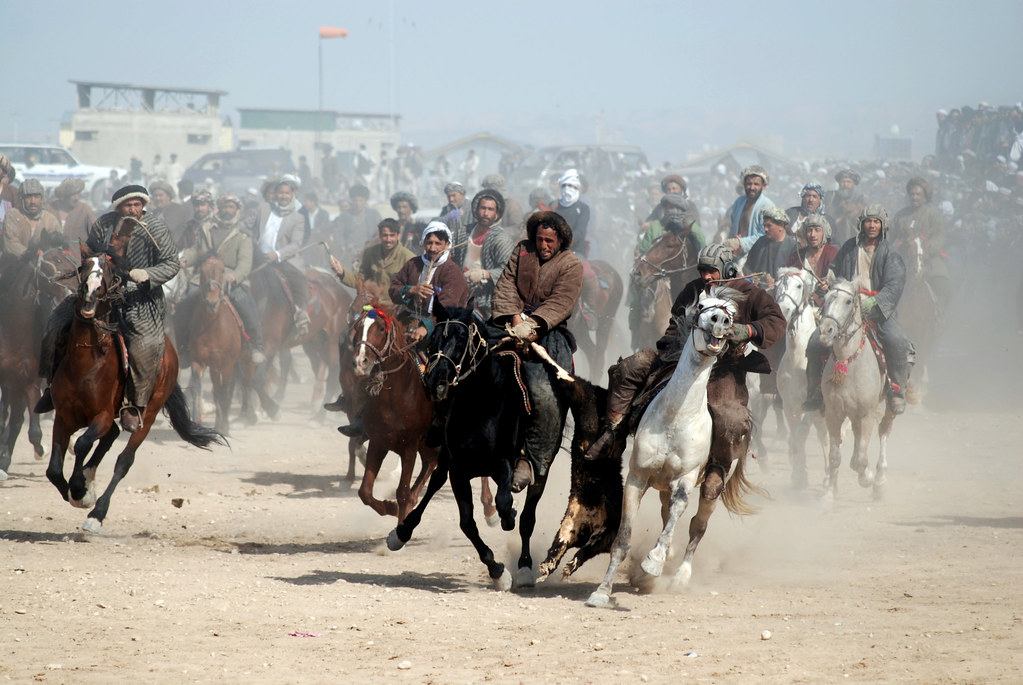
Buzkashi (Kazakhstan, Kyrgyzstan, Tajikistan, Uzbekistan, Turkmenistan and northern Afghanistan)
- Name of sport (game): Buzkashi or Oglak Tartis
- Name in native language: Persian: بزکشی (bozkaszī), Tadzhik: бузкашӣ (buzkaszī), translation: "goat pulling"
- Place of practice (continent, state, nation):
Part of Asia (Kazakhstan, Kyrgyzstan, Tajikistan, Uzbekistan, Turkmenistan and northern Afghanistan), mainly in mountainous areas.
- History:
Sport was created in the 13th century. Most likely in Mongolia during the Chyngis Khan's reigns. In the past, very often a wolf had kidnapped a sheep from a herd. Then the shepherds start a pursuit to catch the animal, when they bag a wolf, they cut its throat. In that, they earn respect among other shepherds and interest among the fair sex. Most likely, due to the lack of wolves, goats are used for the game.
When in 1996 the Taliban began to rule in Afghanistan, buzkashi became forbidden. After the fall of the regime in 2002, the game became legal again.
Around the most important royal buzish competitions taking place in Kabul, the story of Joseph Kessel's book "Riders" (French: Les Cavaliers) and the films based on it from 1956 and 1971 takes place. Moreover,Buzkashi was featured in Rambo III (1988) when Sylvester Stallone was actually seen playing the game.
In the 1940s, a group of men in Cleveland, Ohio introduced a version of the game in the United States. They called the game “Kav Kaz.” It only lasted for less than a decade.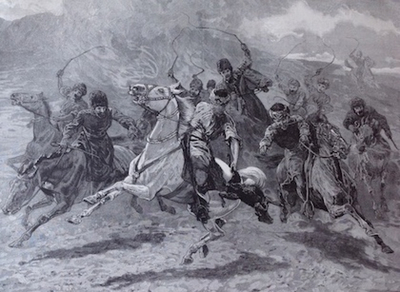 "Herati horsemen playing the 'Baz Gadeh Bazi' or goat-neck game. Scenery and life in Afghanistan," from sketches by Sir Edward Durand. The Graphic, 23 September 1893, p. 377.
"Herati horsemen playing the 'Baz Gadeh Bazi' or goat-neck game. Scenery and life in Afghanistan," from sketches by Sir Edward Durand. The Graphic, 23 September 1893, p. 377.
Source: https://trc-leiden.nl/trc-digital-exhibition/index.php/afghan-dress/item/89-buzkashi-garments - Description:
Two teams of riders on horseback take part in the game. In unofficial games, there is no predetermined number of players, whereby additional players can join in the playing team. The task of the players of each team is to pick up a body of a goat with cut off head which lies in the middle of the field on marked circle (nowadays instead of the body of a previously killed animal, a loaded bag made of lambskin or calf is used), transported around the field and dropped to "Goal", which are marked by circles on the earth. The task of the opponents is to take "the ball" away from the opponents, transport it around the field and throw it into the circle of rivals.Sometimes in order to make the game difficult, the previously prepared bag is soaked for several days in ice water, making it heavier and harder to maintain.
There are hardly any rules in the game. It is allowed to beat a horse or rider, kept (often in teeth) with small whips (knouts), pushing and knocking off a horse. There are no reminders or penalties. In the game, players must demonstrate exceptional physical fitness, dexterity and cunning.
A buzkashi player is called a Chapandaz; it is mainly believed in Afghanistan that a skillful Chapandaz is usually in his forties. This is based on the fact that the nature of the game requires its player to undergo severe physical practice and observation. Similarly horses used in buzkashi also undergo severe training and due attention. A player does not necessarily own the horse. Horses are usually owned by landlords and highly rich people wealthy enough to look after and provide for training facilities for such horses. However a master Chapandaz can choose to select any horse and the owner of the horse usually wants his horse to be ridden by a master Chapandaz as a winning horse also brings pride to the owner. The horses are more valuable in a game of Buzkashi than the player himself. In some cases, a horse may be trained for up to 5 years before playing its first game., They can protect the rider with their own body, when this falls during the fight.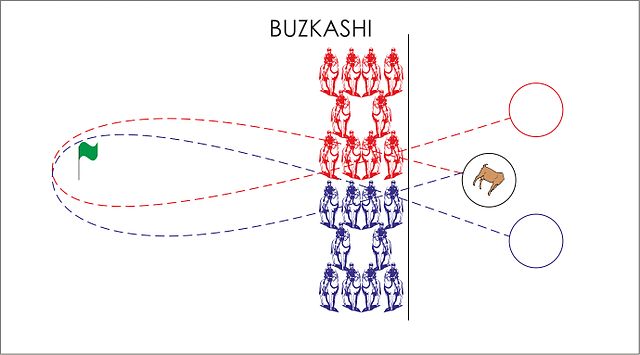
Buzkashi in Afghanistan
Buzkashi is played in Afghanistan in two types:
Team play :
Most famous team from each province will be selected for these competitions and on the field their will be 6 horses from each side on the competition day the game is played for 3 period of 25 minutes.
Group play :
In this type their will be more than 50 horses on the field, and every body will score for their own and take the prize, the owner of horses will gave some money or anything precious for player to encourage them.
Field in Afghanistan has 2 circle for putting the selected animal, and one circle for taking and also a flag on another side of the playing field.
Players must take the animal form circle and go to flag and after turning around the flag then back to the putting circle and put the animal.
Buzkashi is played on winter time on cold weather usually on Friday and on Monday’s small players play on field.
The biggest event of Buzkashi every year held in Mazar e sharif center of Balkh province by the name of ( Mila e gol e sorkh ) which means the red flower party in last days of March, in this event teams come from all over of Afghanistan and try to be the winner.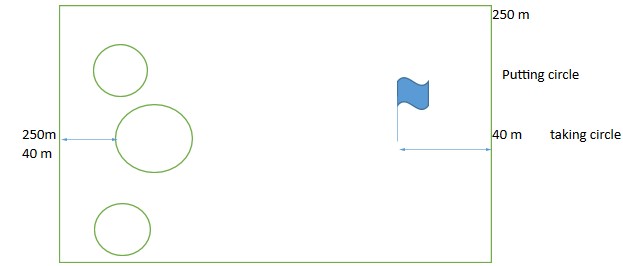
For official games (eg for tournaments in Kabul), the Afghanistan National Olympic Committee has established the following rules and provided penalties:
-The pitch has shape of square, each side is 400 meters long.
-Each team consists of 10 riders.
-Only 5 players can play in each half.
-Half takes 45 minutes.
-The break between takes 15 minutes.
-A judge is watching over the game.
The different types of Buzkashi: Tudabarai & Qarajai
In Tudabarai, in order to score, the rider must obtain possession of the carcass and then carry it away from the starting circle in any direction. The rider must stay free and clear of the other riders.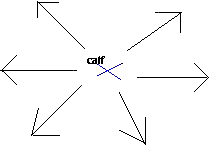
In Qarajai, the task is much more complex. The player must carry the calf around a marker, and then return the carcass to the team’s designated scoring circle.
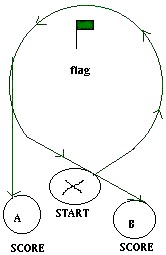
- Current status:
Sport is practiced all the time. Official matches are organized due to various national and other holidays, for example on the occasion of the first day of spring, New Year or Independence Day.
Unofficial matches are organized by ordinary people, e.g. due to circumcision of a son or a wedding. The organizer usually provides rewards for all participants of the game. The richer the family is, the better rewards are, so sometimes you can win a camel, laptop or just money. Information about them [about matches] is given in secret and carried by word of mouth.
There are some organizations, like in Afghanistan there is the Buzkashi Federation.
Every two years, the Nomads Games Festival takes place. Sport is also dynamically developing in other Asian countries. In Turkey, there are also several teams playing with buzkashi. - Sources of information :
G. Whitney Azoy, Buzkashi: Game and Power in Afghanistan, Third Edition. Waveland Press 2011
Miriam L. Stratton, Guests in the Land of Buskashi: Afghanistan Revisited, 1st Book Library, 2002
Hans Heiner, Teona Buhr, Buzkashi, Images from the Central Asian Horse Game near Samarkand, 2011
Fergus M. Bordewich, Buzkashi‐It Is Probably the Toughest Game in the World, https://www.nytimes.com/1973/05/13/archives/buzkashiit-is-probably-the-toughest-game-in-the-world-if-you-go.html
Buzkaszi – Najdziwniejszy sport świata (article in Polish) - http://kolemsietoczy.pl/kok-boru-buzkaszi-najdziwniejszy-sport-swiata/Buskashi (video) - https://www.youtube.com/watch?v=_UB3eA8B4qI
Buskashi (video) - https://www.youtube.com/watch?v=567HopA5Wdc Buzkashi Explained: Mysterious Rules & Traditions (article) - https://www.farwestchina.com/culture/buzkashi-rules-explained/ - Gallery:

